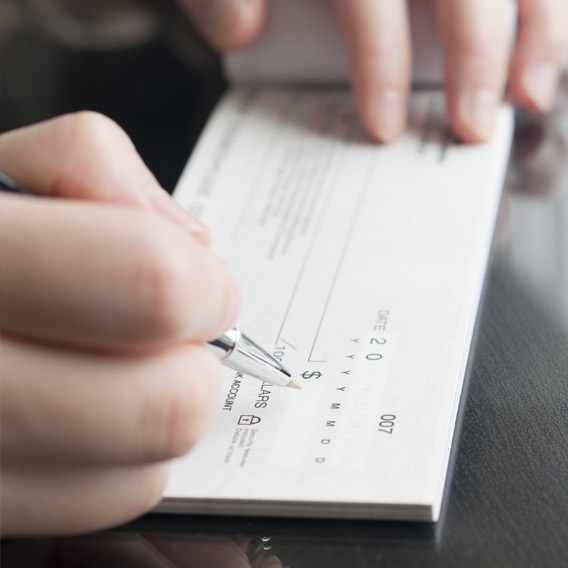CHECKING & SAVINGS
How Much Money Should I Keep in My Checking Account
EXPECTED READ TIME:3 MINUTES
A checking account is the central hub of your personal finances. It allows you to access cash, make purchases, and pay your bills. Plus, with online and mobile features — such as 24/7 access to your account, direct deposit, and bill payment — it’s getting easier (and safer) to manage your finances from your checking account.
However, if you keep too much money in checking, you could miss out on the higher dividends offered by savings accounts, certificates, and investment accounts. So, how much money should you keep in checking? Here’s how to decide.
Decide on a Monthly Checking Balance
Start by determining how much you need each month to cover your bills and day-to-day expenses. Review your budget and make updates if needed. Once you know what you spend each month, keep one to two months’ worth of expenses in your account plus a buffer.
Track Your Expenses for Better Accuracy
If you’re having trouble getting started, think about your monthly automatic payments and other costs such as:
- Mortgage/rent
- Utilities
- Transportation
- Credit card payments
- Student loans
- Internet and streaming services
- Phone bill
- Healthcare expenses
- Groceries
- Social expenses like lunch with coworkers or drinks with friends
You can most efficiently track your expenses by using a personal finance app, reviewing your checking account and credit card statements, or using the mobile banking app from your credit union or bank.
Maintain a Minimum Balance
Another factor to consider when deciding how much money to keep in your checking account is your financial institution's minimum balance requirement. Most credit unions and banks require you to have a certain minimum balance in your checking account to keep it open and avoid fees.
On average, these balance amounts can range from $100 to $2,500, although there are accounts with no minimum balance requirement.
You can most efficiently track your expenses by using a personal finance app.
Cushion Your Balance to Avoid Overdrafts
Money is constantly moving in and out of your checking account, making it easy to come up short. That’s why many experts advise having an extra buffer amount in your checking account — preferably enough to cover 30% of your monthly expenses. A buffer protects you from:
- Overdrafts and returned check fees
- Maintenance fees or penalties for falling below your minimum balance
- Pre-authorization holds
Buffers also cover non-routine expenses that are hard to budget for like birthday or holiday gifts, fluctuating expenses like utility bills that vary seasonally, one-time annual subscriptions or payments, or other special occasions. They also provide liquid funds in a pinch.
Many experts advise having an extra buffer amount in your checking account — preferably enough to cover 30% of your monthly expenses.
What Is Overdraft Protection?
Overdraft protection is a feature that covers purchases and transactions you make if you don't have enough money in your checking account (which despite your best intentions, can happen sometimes).
Basically, overdraft protection allows transactions such as checks, debit card purchases, and ATM withdrawals to still clear when you’ve overdrawn from your checking account. The money used to cover the transactions comes from another backup account, such as your savings account, a credit card, or line of credit, that’s linked to your checking.
Although overdraft protection can give you peace of mind in case you overdraw, here's why you don't want to rely on it:
- You're responsible for paying back the amount you've borrowed from your backup account. Financial institutions generally charge an overdraft fee, which can be anywhere from $20 – $50. The average overdraft fee as of December 2023 is $26.61.
- If your backup source is a line of credit, you'll also have to pay interest on that borrowed amount until you pay it down.
- If the amount you overdraw is more than the amount in your backup account, your transaction will be declined and you will be charged a nonsufficient funds fee (NSF). As of December 2023, the average NSF is $33.58.
Overdraft protection is a feature that covers purchases and transactions you make if you don't have enough money in your checking account.
Use Leftover Income Wisely
Once you have a good idea of how much you need in checking to cover your bills, basics, and buffer, your next step is deciding how to manage anything left over. Deposit the leftover money into a high-yield savings account, start an emergency fund, or add it to your retirement fund. Not only will your money grow faster in these types of accounts, but you'll be less likely to spend it.
Not only will your money grow faster in accounts designed for saving, but you'll be less likely to spend it.
The Takeaway
Having the right tools and resources can help you determine how much money you should keep in your checking account. If you keep enough to cover regular expenses, stay above any minimum balance requirements, and avoid overdrafts, your checking account will be a great financial resource.
Check Out PenFed's Checking Accounts
See the features and benefits of PenFed's checking account.




